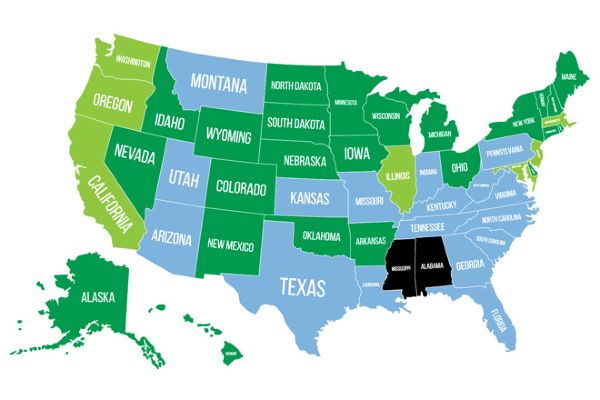By Matthew D. Batastini and Sarah H. Fay, Schwartz Hannum, PC
As of early May 2019, independent schools and other employers in at least five states must be able to demonstrate that women and men receive equal pay for “comparable” or “similar” work. Schools in at least 14 other states are banned from asking job candidates about their past salaries, under laws meant to prevent prior pay disparities from perpetuating at new employers. How are the new laws uniquely challenging for independent schools, and what steps can you take to ensure compliance?
Efforts To Address the Pay Gap
Depending on which source you credit, women are paid between 78 and 85 cents per dollar earned by men in comparable jobs. Notably for schools, the pay gap between college-educated women and men is actually greater than the overall gap. This pay gap is marked each year by Equal Pay Day – a “moving” holiday that is designated by the date a woman would have to work into the current year to earn the same as a comparable man earned in the prior year. In 2019, Equal Pay Day was observed on April 2.
Clearly, the legal framework created by the federal Equal Pay Act of 1963 and state analogues have not done enough to narrow the wage divide. There are two key reasons why. Most notably, the requirement of demonstrating “equal” work, as required to state a claim, has been construed narrowly by courts and is notoriously difficult to satisfy. So, two job positions that look similar might not be considered “equal” under the law.
The Act also contains a broad defense permitting disparate pay based on any “factor other than sex,” which has allowed employers to rely on salary history and market conditions to set compensation, thereby perpetuating existing gender pay differences. Driven in part by these limitations, Equal Pay Act claims represented only 1.4 percent of the claims filed with the Equal Employment Opportunity Commission during 2018.
With reform efforts on the federal level in gridlock, states have begun passing laws designed to remove the barriers of the Equal Pay Act and its progeny. California, Massachusetts, New Jersey, Oregon and Washington have new laws on the books requiring equal pay for “comparable” or “similar” (rather than “equal”) work. This more malleable standard requires pay equity among employees whose specific job duties are different, so long as their positions demand comparable (or similar) skills, responsibilities, effort and working conditions. Many of these new laws have also eliminated the “factor other than sex” defense, thereby prohibiting employers from relying on prior compensation or market conditions to justify disparate pay. Notably, the remedies for successful claims under these new laws – such as statutory back pay, liquidated (double or treble) damages and mandatory attorney’s fee awards – raise the stakes significantly for employers.
Still more states have passed restrictions on asking job candidates about their past salaries. These laws, which have been passed in states including Connecticut, Delaware, Hawaii, Illinois, North Carolina, New York, Pennsylvania and Vermont, seek to prevent prior pay disparities from perpetuating at new employers.
Pay Equity Challenges for Schools
For schools in jurisdictions with new equal pay laws, the most immediate priority is to ensure that hiring practices are compliant. If hiring is decentralized, you may need to coordinate this effort among several departments. Remove any questions about prior compensation from all employment applications, pre-employment questionnaires and similar documents. Train hiring managers and other employees who interview job candidates on impermissible questions under the applicable state law. And finally, direct any external recruiters or staffing firms to comply with new state law requirements, as their actions during pre-employment screenings will be imputed to your school.
The substantive requirements of the new equal pay laws also present unique challenges for schools whose workforces are often far from homogeneous. Because schools typically have few employees with the same title, comparisons between departments can be challenging to identify and to quantify. By way of illustration – does an associate director of admissions have to be paid equally to an associate director of advancement? At some schools, perhaps; at other schools, likely not. Such comparisons are highly fact-specific and require analysis of both the respective jobs (required skills, effort, responsibilities and working conditions) as well as the individuals in those jobs (experience, seniority or job performance). Even comparisons between faculty can prove difficult, as many teachers carry advising, coaching or residential duties in addition to their classroom work. Further complicating the analysis is the broad definition of “compensation” under the new laws, which may include benefits like 403(b) matching contributions, campus housing and tuition remission.
If your school is in a jurisdiction with new equal pay laws, we recommend undertaking an audit of employee compensation to identify potential inequities. In some states, carrying out such an audit will provide the school with a partial or full defense to future pay equity claims. Experienced counsel can guide your schools through an equal pay audit and provide counsel on how to address any disparities that are identified.
Matthew D. Batastini is co-managing partner and Sarah H. Fay is an attorney at Schwartz Hannum, PC. Both are members of the firm's Education Practice Group.
Download a PDF of this article.




